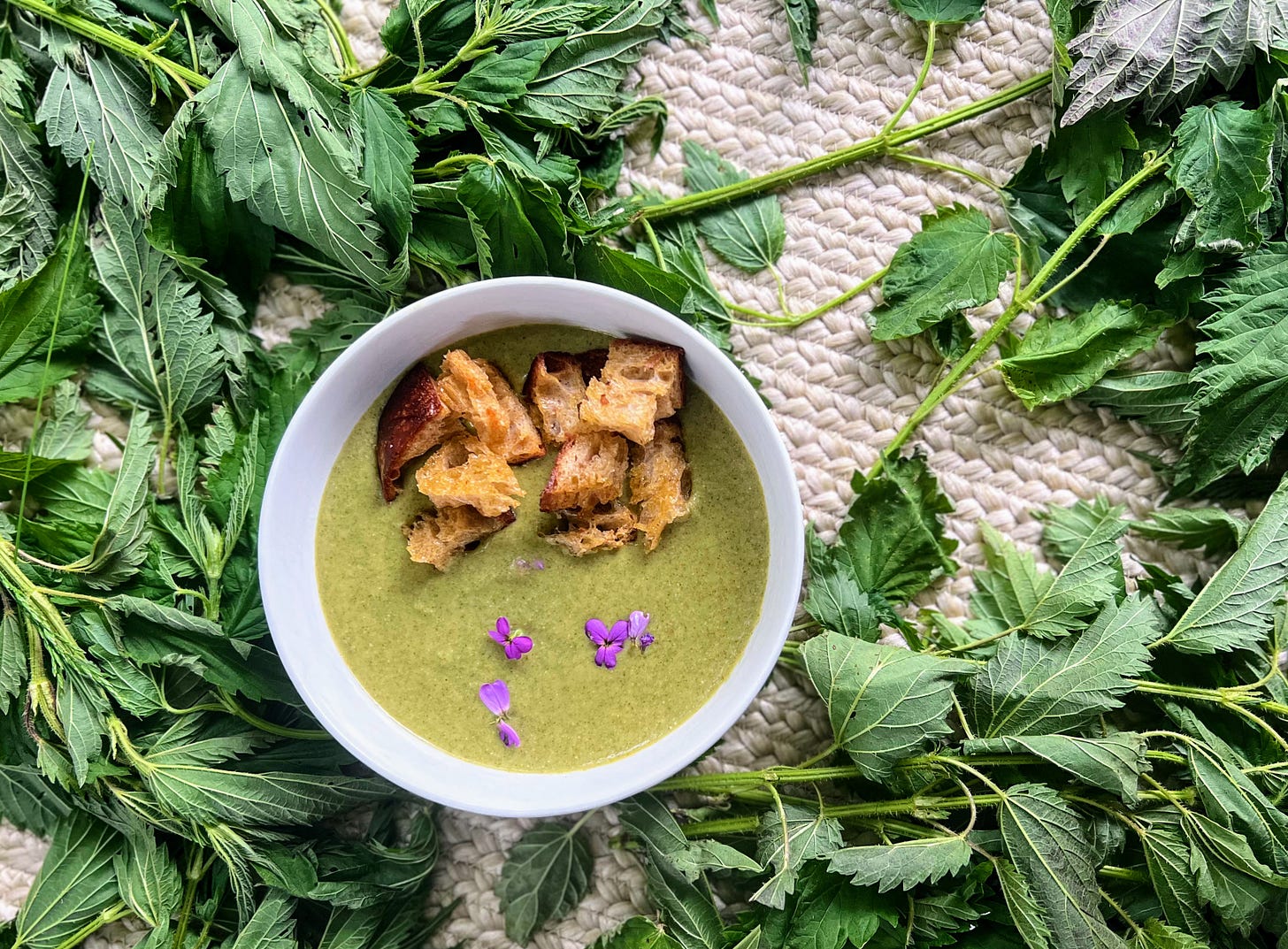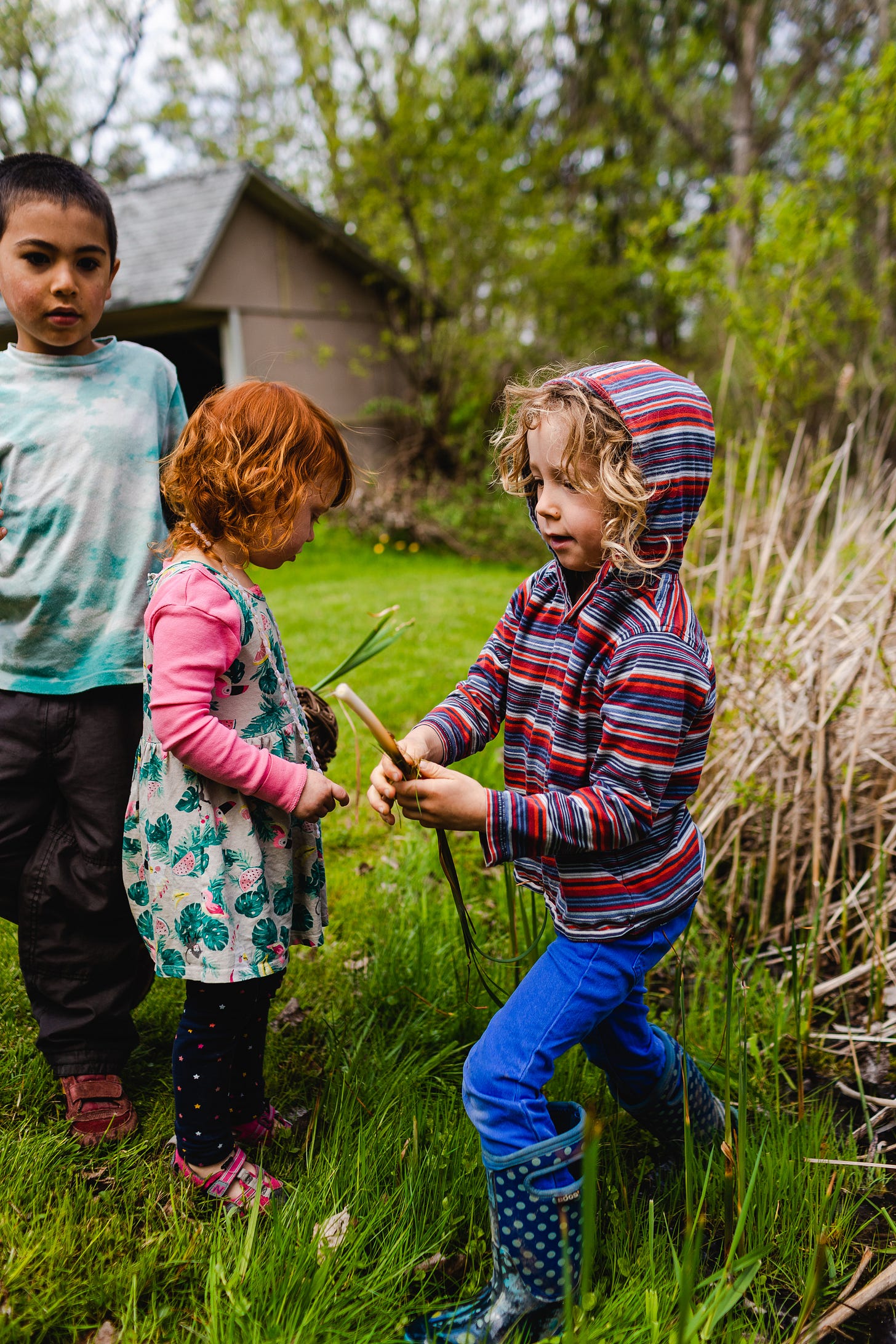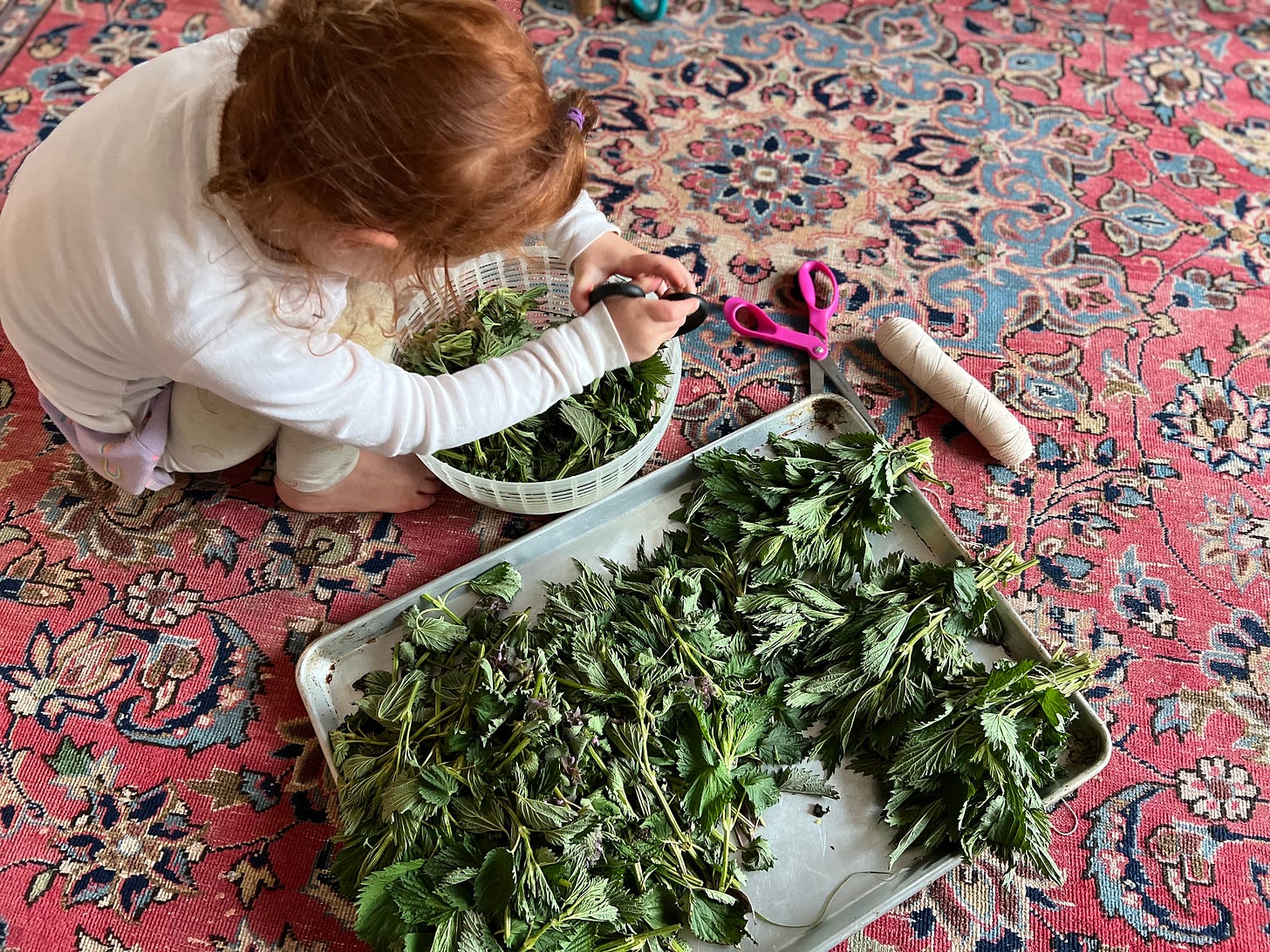Inside this letter: An invitation to introduce yourself to one new plant this weekend, and a simple recipe to stay afloat as you ride the current of Spring into Summer. Head to the bottom for the recipe (with substitutions, shortcuts, and GF / V options).
Hello friends!
The other day I saw a post on Instagram of a teenager standing in a nondescript patch of land on the side of a parking lot, holding a bouquet of plants. The caption read something like this: “She knows what she’s harvesting, but I wouldn’t know where to begin.”
For most of my life, when I looked at a forest or meadow, I just saw a “green wall.”
I knew some plants well: Poison Ivy (and its antidote, Jewelweed), Wild Onions, Maple, Dandelion. After running through a patch of Nettles in my grandfather’s garden in Kent, England, I never overlooked them again.
I was familiar with the cultivated fruits, vegetables, and herbs in my mother’s garden, u-pick farms, and the farms where I worked.
But in the wild, I mostly saw unidentifiable, indistinguishable green.
It wasn’t until I moved to Ithaca, New York in my late 20’s that I began to recover the ancient wisdom of wild food and medicine for myself. My enthusiasm for local food connected me to people who were stewards, caretakers, and advocates of upstate New York’s ecosystems. And as I quickly learned, wild foods flourished in these ecosystems.

My dear friend, Sarah Kelsen, first introduced me to many beloved plant friends: Wild Cranberries, Cornellian Cherries, Ramps, young Cattail stalks, Wild Ginger, and the first Basswood leaf snacks of Spring.
Thanks to generous teachings from foragers and educators like Sarah, I began to see - really see - that the unruly patches in our yard were teeming apothecaries and gardens (or “yardens,” as coined by Mallory O’Donnell). I can still remember my first walk on the trails at Firelight Camps with Sarah (where she guides plant walks). How empowered I felt to know what gifts were generously growing underfoot and overhead! How my devotion to the Earth exploded tenfold!
It became a ritual for Sarah and I to walk together, taking nibbles and referring to our favorite guide books. Over time these walks became rituals with our children, carried on our backs or trailing behind us.
More than a decade after moving here, I’ve walked alongside many friends who hold a wealth of knowledge about wild plants and fungi (and not just those that are edible) - you know who you are.
These days, I walk behind my children and their friends, marveling at how they confidently taste Oxeye Daisy’s sweet leaves and suck the honeyed nectar of Lungwort.

I feel we are far from recovering all the wealths of plant wisdom that many of our ancestors had. But I have been fortunate to find friends and mentors who have guided me towards a path of restoring a precious body of plant knowledge that enriches nutrition, provides medicine, and amplifies flavor. This journey of re-discovery has been a collective process for me in my community, and I would love for more people to be able to feel the benefits I have. I would love to continue to share what I’ve learned with others who are interested. We can hold, nurture, and share this knowledge together as one more way to build connections to ecosystems and to each other.
To the person who wrote that Instagram post, I would say, begin slowly.
Start by getting to know - really getting to know - ONE plant. Greet it like a new friend. Learn its many names. Study it in every stage of life, from seedling to blossom. Discover how it likes to grow and to be harvested, how it can heal and nourish you. Ask friends or experienced guides to share their favorite qualities about it.
Establish a relationship.
This kind of learning can be a step to building a more loving, mutual relationship with ecosystems on Earth that sustain us - and other beings - every, single, day.

So, as you ride the hum of spring into the holiday weekend, I invite you to introduce yourself to one new plant wherever you are. Perhaps it lives in a sidewalk crack in your city or on a trailside in a park - remember wild plants are not only in the places we think are “wild.”
However, consider the environment around a plant before you eat it! Is it a high-traffic dog walking area? Is it on the side of the road or downstream from a factory or commercial farm where toxic run-off like gasoline and pesticides can contaminate plants.
*Disclaimer*: YOU are responsible for identifying anything you eat. I recommend checking with 2 credible guides / experienced friends, and 1 guidebook (favorites are by Sam Thayer.)
I’ll leave you with a simple, nourishing recipe using wild nettles: Creamy Potato & Nettle Soup! Not planning to harvest nettles? No sweat. Just leave them out.
If you plan to harvest nettles (which would be in the next week before they’re past prime), you can use thick gardening gloves to handle them, snipping them about halfway down the stem. Once home, strip fresh leaves to add to soup, and tie the remaining stems in bundles to dry. Once dry, you can crumble over a baking sheet and store in a jar to use for tea (excellent source of iron and minerals). You can also powder the leaves in a blender, and store the powder for adding to baked goods.
I hope you take me up on my challenge to kick off summer by breaking down the magnificent “green wall” outside your door, one plant at a time!
On the cusp of the full moon…
Your witch-in-constant-training,
♡ Emma
PS. Did you get your FREE meal plan?
The first monthly meal plan is coming on JUNE 3rd, and it’s a goooood one! All paid subscribers receive a 30-day free trial. Read more about the monthly meal plan subscription here. If you haven’t grabbed your FREE one-week meal plan yet, head to this link. If you know you want it, you can upgrade to paid now:
Creamy Potato & Nettle Soup
Yield: 8-10 servings ⎹ Prep time: 15 min ⎹ Cook time: ~ 30 min ⎹ Level: Easy
This spin on a simple Potato and Leek classic is absolutely divine! With croutons, kids tend to dip and slurp this up too. The potatoes give it a rich, creamy texture amplified by a hint of cream. The nettles paint the soup a beautiful green and add mineral-rich nutrition. Don’t have access to nettles or want to add them? Swap ‘em or ditch ‘em.
Shortcuts: Find smaller potatoes with smooth, thin peels and don’t bother peeling them!
Subs: Swap nettles for fresh or frozen spinach. Kids don’t like green? Leave them out.
GF / V: Swap the heavy cream for coconut milk, use vegan butter, and make (or boy) GF croutons.
Tip: Use the WHOLE leek aside from the root. Do not discard the green parts. Halve the leeks lengthwise and wash the sand out from between the leaves.
Plan ahead: This recipe makes a double batch; freeze half for a quick weeknight meal.
Ingredients:
3 Tbsp unsalted butter
2 leeks, cleaned and coarsely chopped
3 cloves garlic, coarsely chopped
1 tsp salt, plus more for seasoning
2 lbs yukon gold potatoes, unpeele
7 cups chicken broth
3/4 cup heavy cream
Juice of 1/2 lemon
1 generous bunch nettle leaves (optional)
Croutons (optional)
Instructions:
In a large pot, melt the butter over medium heat.
Add the leeks and garlic, and stir to coat in butter. Sauté about 5-10 minutes, until the leeks are soft and wilted, stirring regularly.
Add the potatoes and broth. Stir to mix together, bring to a boil and then reduce to a simmer. Cover and cook for about 20 minutes, until the potatoes are fork-tender.
While the potatoes are cooking, make croutons: Preheat the oven to 350. Slice sourdough or slices of sandwich bread into cubes. Transfer to a baking sheet and generously drizzle with olive oil and season with salt. Bake for 10-15 minutes until toasted and browned. Remove and set aside.
Once potatoes are cooked, add the cream, lemon juice, and nettle leaves if using, and cook until the leaves are wilted and tender.
Use an immersion blender to blend until creamy. If the soup is too thick, add water until you reach the desired consistency.
Serve warm, with croutons.
Store leftovers in an airtight jar or container for up to 5 days in the refrigerator or up to 6 months in the freezer. If freezing in a glass jar, be sure to leave at least 1 inch of headspace from the surface of the soup to the lid to prevent the jar from cracking when the liquid expands.










Beautiful! I have SO MUCH NETTLE. Thank you for reminding me to use it more.